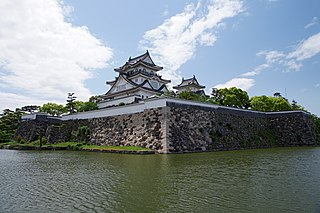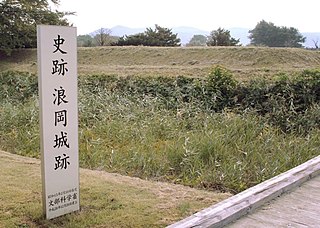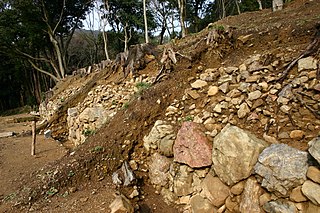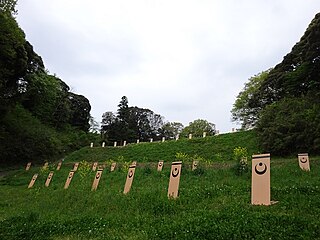
Nagoya Castle is a Japanese castle located in Nagoya, Japan.

Kōhoku-ku (港北区) is one of the 18 wards of the city of Yokohama in Kanagawa Prefecture, Japan. As of March 1, 2012, the ward had an estimated population of 332,488, with 156,198 households and a population density of 10,588.79 persons per km². The total area was 31.40 km². Kōhoku Ward has the largest population of Yokohama's 18 wards, and ranks second to Naka Ward in the total number of workplaces.

Kishiwada Castle is a Japanese castle located in the city of Kishiwada, Osaka Prefecture, Japan. At the end of the Edo period, Kishiwada Castle was home to the Okabe clan, daimyō of Kishiwada Domain. The Honmaru Garden of the castle is designated as a National Place of Scenic Beauty. The castle is also known as Chikiri Castle.

Takamatsu Castle of Bitchū Province was a Sengoku period Japanese castle located in what is today the Kayo neighborhood of Kita-ku, Okayama in Okayama Prefecture. The style of the castle was a hirajō with no stone walls, but only earthen walls. The castle was surrounded by marshes, which formed a natural moat. Its ruins have been protected by the central government as a National Historic Site since 1902.

Fukui Castle is a flatland-style castle located in what is now the city of Fukui, Fukui Prefecture, Japan. During the Edo period, it was the headquarters of a branch of the Matsudaira clan, who were hereditary daimyō of Fukui domain under the Tokugawa shogunate. The castle was also known by the name of Kitanoshō Castle, after an earlier castle built by Shibata Katsuie, over whose ruins it is partly built.

Tsu Castle was a Japanese castle located in the city of Tsu, Mie Prefecture, Japan. During the Edo period, Tsu Castle was home to the Sudo clan, daimyō of Tsu Domain, who dominated the provinces of Ise and Iga under the Tokugawa shogunate. The castle was also known as "Anotsu-jō" (安濃津城) after the ancient name for Tsu. The castle ruins are a Prefectural Historic Site.

Sakura Castle was a 17th-century castle, now in ruins, in Sakura, Chiba Prefecture. It was designated one of Japan's Top 100 Castles by the Japanese Castle Foundation.

Namioka Castle was a Muromachi period Japanese castle located in what is now the city of Aomori, Aomori Prefecture, in the Tōhoku region of far northern Japan. The ruins were designated a National Historic Site in 1940 by the Japanese government.

Torigoe Castle was a Sengoku period yamashiro-style Japanese castle located in the Torigoe area of what is now part of the city of Hakusan, Ishikawa Prefecture in the Hokuriku region of Honshu, Japan. Its ruins have been protected as a National Historic Site since 1985. The National Historic Site consists of the ruins of two castles, Torigoe Castle and Futoge Castle. The two castles were built on two mountaintops with the Dainichi River between them in 1573 as the final bastions for the Kaga Ikkō-Ikki movement.

Okō Castle was a Japanese castle structure located in what is now part of the city of Nankoku Kōchi Prefecture, Japan. It was the original base of power for the Chōsokabe clan who were feudal lords of Tosa Province during the late Muromachi and Sengoku periods and famous as the birthplace of the warlord Chōsokabe Motochika. Its ruins have been protected as a National Historic Site since 2008.

Kuroi Castle was a Sengoku period Japanese castle located in what is now the Kasuga-cho neighborhood of the city of Tamba Hyōgo Prefecture, Japan. It was also called Hogetsu Castle or Hōzuki Castle. Famous as the birthplace of Lady Kasuga, the wet nurse of Tokugawa Iemitsu, it ruins have been protected as a National Historic Site since 1989.

Takiyama Castle was a Japanese castle located in what is now the Tani neighborhood of the city of Hachiōji, Tokyo, Japan. Its ruins have protected as a National Historic Site since 2007.

Ishigakiyama Ichiya Castle was a late Sengoku period Japanese castle in Odawara, Kanagawa Prefecture, Japan. It was one of the most famous among the castles built by Toyotomi Hideyoshi, and was the site of his first meeting with Date Masamune. Its ruins were designated a National Historic Site in 1959.

Kuniyoshi Castle is a castle structure in Fukui, Fukui Prefecture, Japan.

Moto Sakura Castle was a Muromachi period "hirayama"-style castle located on the border of the town of Shisui and the city of Sakura, Chiba Prefecture, Japan. Its ruins been protected as a National Historic Site since 1998.

Chiran Castle is a castle structure in Chiran, Kagoshima, Minamikyūshū, Kagoshima Prefecture, Japan. The site was designated a National Historic Site.

Sadowara Castle is a Japanese castle located in the Sadowara neighborhood of the city of Miyazaki, Miyazaki Prefecture, on the island of Kyushu, Japan. It is also called Tsurumatsu Castle, and later Shōkaku Castle. During the Sengoku period, it was the stronghold of the Itō clan and later was controlled by the Shimazu clan. Shimazu Toyohisa was command of the castle. During the Edo period, the castle was headquarters of Sadowara Domain, which ruled portions of Hyūga Province from 1603 to 1871. The castle site has been a National Historic Site since 2004.

Hachimanyama Castle was a castle in Ōmihachiman, Japan, on the eastern shore of Lake Biwa in Shiga prefecture. It was the home castle of Toyotomi Hidetsugu, the nephew of Toyotomi Hideyoshi.

Kōkukuji Castle was a Sengoku period yamashiro-style Japanese castle located in the Negoya neighborhood of the city of Numazu, Shizuoka prefecture. The ruins have been protected as a National Historic Site since 1975.

Suwahara Castle was a Sengoku period yamashiro-style Japanese castle located in the Kanaya neighborhood of the city of Shimada, Shizuoka prefecture, Japan. The ruins have been protected as a National Historic Site since 1975.



























